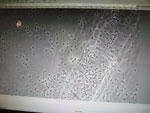Sulfur doesn't smell good
24.07.2008 The activity in the morning was low; some box cores and sediments were collected without great sucsess, and the CTD collected water to search for viruses. The ROV went on strike when it should be used for mapping, and some bacterias had eaten the beautiful preparate from yesterday. Shit! Then there came some kilograms of warm, sulfur-stinking sea bottom on deck, and that did not smell good! But; researchers have to stand that much.

Hovedinnhold
Text and photos by Tove Leinslie, translated by Elinor Bartle
There were many sampling attempts today. There were several box cores for the macrobiologists, but unfortunately they were empty. The gravity corer brought up a short sample of 30-40cm in length. Both indicate that the sediment coating here is not very deep, suggesting that the sea-floor here is relatively young. The microbiologists are filtering some of the water samples for potential microbial organisms.
The microbiologists had a nasty surprise this morning when Jørn went to stain the sulphur bacteria preparation from yesterday - most of the bacteria had been consumed by some other organisms in the mixture!
The challenges continued with the ROV which was equipped with a multi-beam sonar to map the sea floor. A kind of funnel device had also been added to the vacuum sampling device. However, during the descent the funnel fell off! In addition, as the ROV descended it also became evident that the multi-beam sonar had not been sufficiently aligned with the ship's sonar system! The dive had to be aborted in favour of another one equipped with the usual, but tried and tested sampling gear.
The ROV operators are pretty well practiced with taking temperatures and water samples from the vents now. The microbiologists were also anxious to have some sediment samples containing sulphur bacteria. The sediments are multicoloured and the microbiologists are interested to learn more about the different groups of bacteria that may be found in each.
At the evening meeting, cruise leader Rolf B. Pedersen told us that the vent temperatures were warmer than they had been two years ago. In addition, the biomass of the bacteria mats around the vents had also increased. Is geological activity increasing in this area? Is it possible that there may be a new volcanic eruption?
